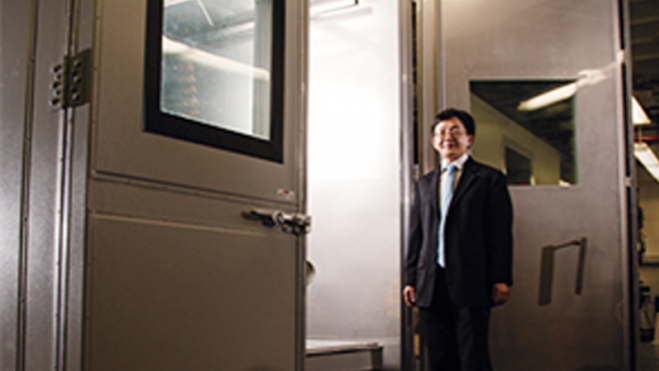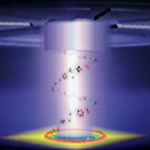Materials Engineering for a More Sustainably Built Environment
Solar photovoltaics is one of the world’s most promising renewable energy technologies. By incorporating solar panels into roofs, skylights, or facades, sunlight can be converted into direct current electricity without harming the environment or depleting resources. Yet typical solar panels can waste a large portion of energy through heat dissipation and efficiency reduction at high temperatures.

Huiming Yin stands next to the Multifunctional Environmental Chamber at Carleton Laboratory used to reproduce climates, accelerate aging, and evaluate energy and environmental impacts. (Photo by Jeffrey Schifman)
But what if solar thermal technology—using that dissipated energy to heat water—could be combined with photovoltaics? That’s the question Huiming Yin, associate professor of civil engineering and engineering mechanics, asked and answered by developing an advanced functionally graded material (FGM). His FGM makes it possible to efficiently marry photovoltaics and thermal technology with a novel building integrated photovoltaic thermal (BIPVT) system that produces both electricity and hot water.
“As a civil engineer, I see the problems with our aging civil infrastructure as a challenge to develop materials and designs to not only improve their durability but also enhance energy efficiency,” he says.
Sustainable development—the balance of economic, social, and environmental objectives—is inherent in civil engineering and is what drives Yin.
 A Horiba high-resolution glow discharge profiler for element analysis
A Horiba high-resolution glow discharge profiler for element analysis
“I am passionate about designing and developing new materials and integrating them into the envelopes of civil infrastructure for both energy harvesting and infrastructure protection,” he explains.
His hybrid BIPVT research, which incorporates a rapid and stable method to manufacture the material, has garnered enthusiastic support from the National Science Foundation, the Department of Energy, and private industry.
“Now we are scaling up the manufacture and commercializing the technology,” he says.
Key to Yin’s research is a focus not only on hybrid materials development, but also on understanding and enhancing a longer lifecycle for structural materials. He established the Sustainable Engineering and Materials Laboratory at Columbia, in affiliation with the Carleton Laboratory, to deeply delve into investigating lifecycle performance characterization. He developed a multifunctional environmental chamber with industry partners to reproduce various service environments, provide accelerated aging stresses, and measure energy and mass flow in a system.
“There is an emerging need for experimental methods and facilities in lifecycle performance characterization. A longer lifetime of a structural material means a lower annual energy input,” he explains. “I’m excited about this new research direction approaching the goal to improve the sustainability of civil infrastructure through discovery, design, and development of advanced materials, structures, and systems.”
